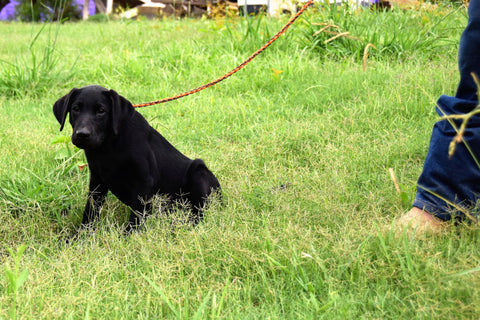House breaking your puppy is an extremely important step in any puppy’s training, even if you plan on keeping it outside or in a kennel as it grows up. House breaking, like crate training, is another way to introduce your puppy to positive reinforcement and to one of the most important words in training, NO.
You may wonder why you will need to house break your puppy if you plan on keeping it outside or in a kennel. First off, if your pup doesn’t use its kennel as a bathroom, then that means less cleanup for you. Also, situations may arise that require your dog to stay inside with you, such as travel, weather, or health problems that require low exercise and monitoring. Properly done, house breaking should only take a couple of weeks. So how do you get started? Following these basic house breaking procedures will make this portion of training a breeze.
Establishing a Regular Schedule
Like raising a child, establishing a schedule is important for your puppy. Your puppy should have an established time for eating, going out to potty, and playing. Generally speaking, a puppy has to go to the bathroom within 5-10 minutes of waking up or eating, so take it outside immediately after it wakes up or gets done eating, and wait with it until it goes. Bodily functions also tend to speed up during playtime, so it’s a good idea to take your puppy out after playing. Ways to help you establish a schedule include:
- Use a Consistent Feeding Schedule- Puppies are ferocious eaters, and your puppy will need to eat multiple times a day. Feeding at a consistent time will help ensure that your puppy will need to go out at a consistent time.
- Pick a Bathroom Spot- Dogs generally like to eliminate in the same area over and over. Taking your puppy out to the same spot will help it associate that area with using the bathroom. Also, the scent will help remind the puppy that it needs to go.
- Go Outside Often- Keep in mind that your puppy has a small bladder with limited control over it. You should take your puppy outside AT LEAST every two hours, along with immediately after waking up, eating or drinking, or playing.
- Limit Water Before Bedtime- Start putting up your puppy’s water bowl a couple hours before bedtime. This will help eliminate accidents while you are sleeping.

Taking Your Puppy Outside
- Use a Keyword- When you take your puppy outside, use a keyword, such as “potty”, while it is eliminating. Eventually, you will be able to use it as a reminder when you take it outside. Don’t be too commanding, as your puppy may get distracted and not finish what it started.
- Pile on the Praise- Your puppy should associate good behavior with a reward. Some people like to give a treat, some people just like to praise lavishly. We recommend both for the first few days because puppies are highly responsive to food and it helps to associate praise with a reward. However, we tend to put the treats away fairly quickly since food shouldn’t be the only thing that motivates your puppy to please you. Remember to always wait until your puppy is finished before you reward it as this may lead to the puppy forgetting to finish until it’s back in the house.

Preventing Accidents
The best way to prevent accidents is to not give your puppy an opportunity to go to the bathroom inside. Establishing a schedule goes a long way toward preventing accidents inside the house. Along with introducing a feeding schedule, limiting night time water consumption and taking your puppy outside frequently, here are some other tips to help you prevent an accident from occurring.
- Supervision- When your puppy is inside, treat it as you would a baby that is just learning to crawl and NEVER let it out of your sight. Watch for warning signs that it may need to go outside. Some signs include restlessness, sniffing around, squatting, or scratching at the door. Through a little simple observation, you will begin to pick up on these warning signs fairly quickly.
- Confinement- You won’t always be able to keep an eye on your puppy. When you have to leave, or when it’s time to sleep, keep your puppy confined to its crate. Puppies naturally don’t want to use the bathroom in a place they sleep or eat in. Always be sure to take your puppy directly to the yard when you let it out of confinement.
What if My Puppy has an Accident Inside?
Be prepared for this as it is likely to happen more than once during the house breaking process. No matter how vigilant you are, it only takes a second for a puppy to stop and squat.
- Keep Your Cool- Don’t punish your puppy for soiling the living room floor as it hasn’t been introduced to pressure and you will just end up making it scared of you or scared to eliminate in front of you, prolonging the house breaking process.
- Thoroughly clean the area. As mentioned before, dogs like to use the bathroom in the same area and any scent left behind may motivate your puppy to continue to use the area.
- Take it Outside- If you catch your puppy in the act, don’t wait for it to finish. Without scaring it, startle it with a firm “NO!” and immediately take it to its bathroom area in the yard and wait for it to finish. When it does finish, be sure to heap on the praise.

As with any other portion of your puppy’s training, always remember to stay calm when things don’t go the way you want and reward your puppy heavily when it does what you want. Follow these suggestions and house breaking shouldn’t be a headache.
Don’t forget that you can email any of your questions to dogs@honeybrake.com and we will be happy to follow up with you. Our next topic will be simple obedience so be sure to check back next Monday. As always, good luck with your gun dog!

